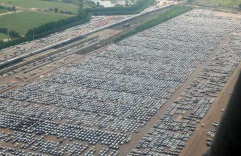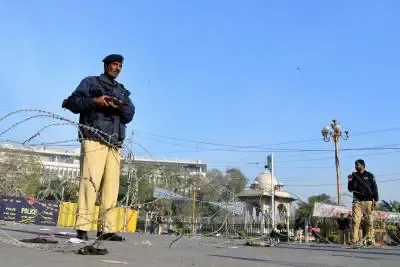Are Heatwaves and Droughts Plaguing Europe Demanding Global Action?

Synopsis
Key Takeaways
- Extreme temperatures are affecting Europe, with forecasts predicting highs exceeding 40 degrees Celsius.
- A new report indicates that drought is becoming more widespread and severe globally.
- Climate change is a significant driver of these extreme weather patterns.
- Immediate action is required to address the escalating crisis.
- Collaboration among nations is essential to mitigate the effects of drought.
Bucharest, July 3 (NationPress) As extreme temperatures and worsening drought conditions seize significant portions of Europe, the region is facing a surge in wildfires, leading to urgent weather alerts across various nations.
Experts and international organizations caution that this crisis signifies a broader "new era of drought," exacerbated by climate change and presenting increasing dangers to food security, ecosystems, and national economies.
On Wednesday, Germany is likely witnessing its hottest day of the year, with the German Weather Service predicting temperatures could soar to 40 degrees Celsius. They have issued severe heat warnings throughout much of the country, emphasizing a growing wildfire risk, especially in the southeast.
Similar severe conditions are unfolding in Central Europe. The national meteorological institute in the Czech Republic has raised alarms about "very high temperatures" and heightened fire risks, with some areas forecasted to reach 37 degrees Celsius, according to Xinhua news agency.
Emergency services in Prague have already responded to numerous heat-related incidents, and a fire ban is currently in place.
Slovakia has issued its top-level red alert for 10 districts, predicting highs of up to 38 degrees Celsius as warm air masses from the west exacerbate the heat.
Nearby, Croatia and Romania remain vigilant, with peak temperatures anticipated to reach 39 degrees Celsius and 37 degrees Celsius, respectively.
The Netherlands has confirmed its first official heatwave in three years, with the Royal Netherlands Meteorological Institute reporting five consecutive days above 30 degrees Celsius, leading to a code orange alert in southeastern provinces.
Southern Europe is also suffering. Spain continues to endure a record-setting heatwave, with June 2025 being the hottest month on record.
The Spanish meteorological agency AEMET documented an average monthly temperature of 23.6 degrees Celsius, surpassing typical July and August averages. Tragically, two farmers lost their lives due to a wildfire that devastated 5,000 hectares in La Segarra, northeast Spain.
In Slovenia, the Environment Agency (ARSO) indicated that June 2025 was not only the hottest but also the driest month on record, with rainfall registering just 24 percent of the monthly average.
Heatwaves persist in Croatia, where the Croatian Meteorological and Hydrological Service (DHMZ) forecasts maximum temperatures of 37 degrees Celsius on Wednesday and 39 degrees Celsius on Thursday.
Bosnia and Herzegovina issued an orange weather warning for July 3 and 4, with temperatures expected to reach between 35 and 40 degrees Celsius. Meteorologist Bakir Krajinovic from the Federal Hydrometeorological Institute stated that June 2025 was unprecedented in the country’s measurement history, with zero rainfall recorded in cities like Tuzla and Mostar.
These worsening conditions across Europe are part of a global trend. A new report, "Drought Hotspots Around the World 2023-2025," paints a concerning picture. Jointly prepared by the UN Convention to Combat Desertification (UNCCD) and the U.S. National Drought Mitigation Centre (NDMC), the report warns that drought has emerged as one of the most widespread and damaging crises of our era.
According to Daniel Tsegai, a program officer at UNCCD, "Drought used to be mainly linked to rainfall and agriculture. Now, it is a multi-sectoral, systemic shock. No sector, economy, or country is exempt from its effects."
The report indicates that the frequency of global droughts increased by 30 percent between 2000 and 2019. Driven by climate change and the increasing demand for land and water, droughts now threaten food supplies, water availability, biodiversity, energy systems, and public health, all essential pillars of society.
Mark Svoboda, co-author and founding director of NDMC, described the situation as "a slow-moving global catastrophe, the worst I've ever witnessed."
The economic impact is rising swiftly. NDMC research refers to an OECD estimate that the financial burden of drought today is at least twice what it was in 2000, with further increases of up to 110 percent expected by 2035.
Co-author Cody Knutson stated, "Ripple effects can transform regional droughts into global economic shocks. No nation is safe when vital water-dependent systems begin to fail."
The report warns that drought is already costing some nations up to 10 percent of their GDP each year, and it may soon disrupt energy grids, food supply chains, and entire ecosystems.
The UNCCD urges nations to take immediate action by investing in early warning systems, drought monitoring, and nature-based solutions like watershed restoration. Establishing resilient infrastructure, such as off-grid energy and alternative water technologies, is also vital.
Tsegai emphasized the need for a shift from reactive crisis management to proactive, long-term planning to combat drought. Addressing these interconnected threats requires coordinated action across sectors and governance levels, involving ministries, local communities, and national governments.
Although over 80 countries have crafted national drought plans, the UNCCD cautions that implementation remains a significant gap. Experts warn that without stronger execution and collaboration, the world could face increasingly severe and widespread drought-related crises.










